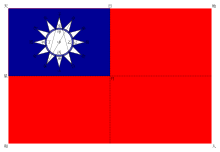Flag of the Republic of China
The flag was originally designed by the anti-Qing group, the Revive China Society, in 1895 with the addition of the red field component in 1906 by Sun Yat-sen in his speech.The public display of this flag is still seen in historical museums and war cemeteries across mainland China, but its use otherwise remains illegal due to its history as a symbol of opposition to communism.[7] The canton (upper corner on the hoist side) originated from the "Blue Sky with a White Sun flag" (青天白日旗; qīngtiān báirì qí) designed by Lu Haodong, a martyr of the First Guangzhou Uprising of 1895.Lu Hao-tung's "Blue Sky with a White Sun" flag was used in the provinces of Guangdong, Guangxi, Yunnan, and Guizhou.In Jiujiang, the "Blue Sky, White Sun, and a Wholly Red Earth" flag was used on ships during a naval uprising.[11] Sun Yat-sen, however, did not consider the five-coloured flag appropriate, reasoning that horizontal order implied a hierarchy or class like that which existed during dynastic times.As a compromise, the Japanese suggested adding a triangular yellow pennant on top with the slogan "Peace, Anti-Communism, National Construction" (和平反共建國; Hépíng fǎngòng jiàn guó) in black, but this was rejected by Wang.After the Chinese Civil War began to ease, the government of Chiang Kai-shek relocated the Republic of China to the island of Taiwan, whose administration was handed over to the ROC from Japan in 1945.On the mainland, the communist forces of Mao Zedong established the People's Republic of China and adopted their own national flag.Sun Yat-sen added the "Red Earth" to the flag to signify the blood of the revolutionaries who sacrificed themselves in order to overthrow the Qing dynasty and create the ROC.The flag has developed a great deal of additional symbolism due to the unique and controversial political status of Taiwan.Schoolchildren have traditionally been required to attend morning rallies where the flag is raised after a rendition of the National Anthem of the Republic of China.The symbolism of the ROC flag began to shift in the early 21st century[citation needed] as there was a warming of relations between the pan-Blue coalition in Taiwan and the Chinese Communist Party on mainland China.Although supporters of Taiwan independence, such as former president Chen Shui-bian, will display and salute the flag on formal official state occasions, it is never seen at political rallies of the Democratic Progressive Party.[19] Some Hong Kongers have historically flown the ROC flag to demonstrate their shared opposition to the PRC's policies, as well as to honor the legacy of Sun Yat-sen, as part of the pro-ROC and pro-democracy camps.





Proposed flags of TaiwanList of Taiwanese flagsFive Races Under One UnionFlag of Chinastate flagnational ensignRevive China SocietyGuangzhou governmentcantonLu HaodongSun Yat-senBlue Sky with a White SunNaval jackWar flagPresidential standardTraditional ChineseSimplified ChineseStandard MandarinHanyu PinyinBopomofoWade–GilesTongyong PinyinYue: CantoneseYale Romanizationtwelve trianglesmainland Chinanational flagRepublic of ChinaNationalist governmentChinese RepublicROC constitutionChinese Civil Warfounding of the People's Republic of ChinaFree AreaTaiwanPenghusome remaining offshore islandsFujianSouth China Sea Islandsmuseumswar cemeteriesTaiwanese independenceChinese nationalismKuomintangDemocratic Progressive PartyFlag of the Qing dynastyChina Burma India Theaterflag of the United StatesBlue Sky with a White Sun flagSociety for Regenerating ChinaHong Kongcoat of arms of the Republic of ChinaGeorge YeoWan Qing YuanXinhai RevolutionGuangdongGuangxiYunnanGuizhouJiujiangWuchang UprisingShanghaiethnicities of ChinaManchuMongolTibetangovernment of the Republic of ChinaYuan ShikaiNational AssemblyGuangzhouNorthern ExpeditionBeiyang governmentCantonesethe Second Sino-Japanese WarJapaneseReformed GovernmentNanjingWang JingweiChongqingChiang Kai-shek1947 Constitution of the Republic of ChinamainlandMao ZedongPeople's Republic of ChinaLegislative YuanLu Hao-tungmonthsThree Principles of the PeoplenationalismdemocracyNational Daydescendants of the Huang Emperorpolitical status of Taiwanflag of the People's Republic of ChinaChinese unificationTaiwan independenceTaiwan Solidarity UnionfinialPantoneMinistry of the InteriorAlbum des pavillons nationaux et des marques distinctivescolour spacesHexadecimalFather of the NationCommunist PartyChinese Soviet Republicpresidentvice presidentNational Flag Anthem of the Republic of ChinasaluteNational Anthem of the Republic of Chinamartial lawChinese Taipei Olympic Committee flagOlympic GamespseudonymChinese Taipeipan-Blue coalitionLien ChanSun Yat-sen MausoleumChen Shui-bianLee Teng-huidesigns for a specifically Taiwanese flagoverseas ChineseChinese democracy movementRennie's Millpro-ROC